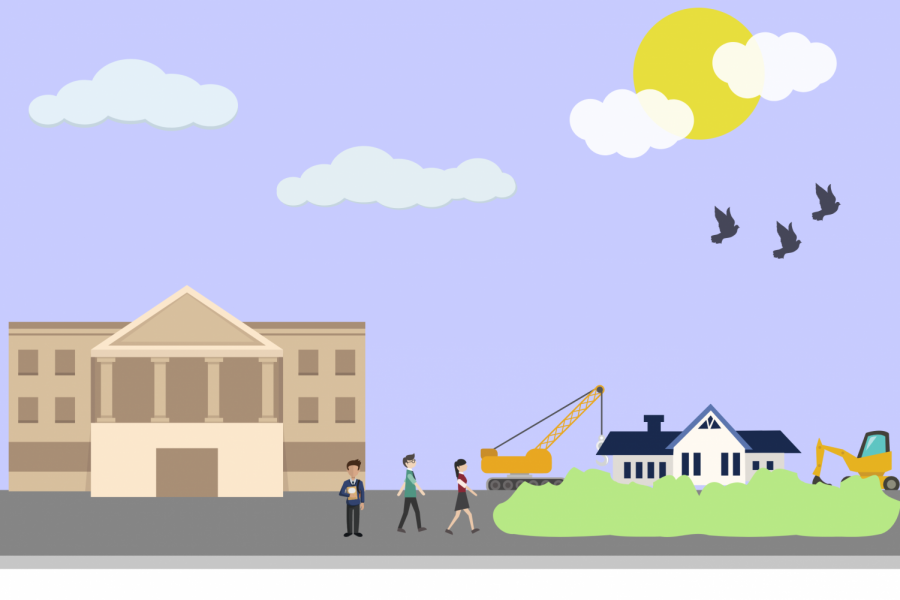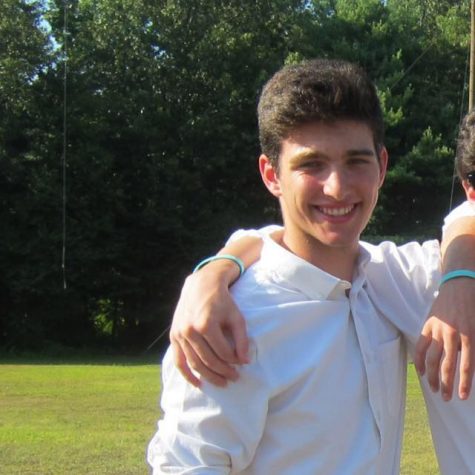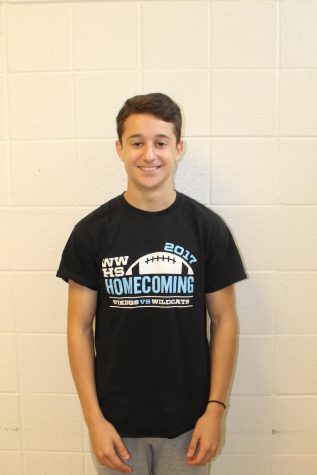From cosmetology to construction, vocational high schools teach career-readiness
At Thomas Edison High School, students have the opportunity to pursue a vocational education, including learning about the construction field.
November 6, 2019
Walter Johnson junior Eliot Eisen’s feet dangled out of a window, 45 feet in the air. Surrounding him was the frame of a house — a house he, along with the construction cluster at Thomas Edison High School, was building. Though unusual for most schools, building during class is a typical scene for students at Thomas Edison High School of Technology.
Edison isn’t a normal MCPS high school. Instead, it’s a vocational high school, created for the purpose of career readiness. Enrolled students have 18 career and technology clusters, or class groupings, to choose from such as construction, cosmetology and cybersecurity. Students attend the school for three, 45 minute-long periods a day and receive 1.5 credits per semester, while also attending their local MCPS high school with an abbreviated schedule.
Vocational education has experienced a spike in popularity in MCPS over the past three years, with Edison’s enrollment jumping from 500 to 850 students. With interest in career readiness education on the rise, the faculty at Edison has become equally as enthusiastic.
“I love the hands-on aspect and how knowledgeable the teachers are in their fields,” Eisen said. “The teachers and school want you to make a career out of this, so they give it their all.”
Eisen belongs to the construction cluster at Edison, and more specifically, the carpentry trade. There are five trades in construction: plumbing, carpentry, HVAC, masonry and electricity.
In the construction cluster, students build one house every one to two years. Once they finish, the houses are sold on the open market. They can sell from $500,000 to $700,000 depending on size and location, and the money cycles right back to the school’s construction foundation to buy new materials and subcontractors.
Edison has a unique “brotherhood atmosphere” that other schools don’t have, Eisen said.
“We all come from different backgrounds, but at the job site we’re just workers,” he said. “We’re all learning and we’re all working together.”
Graphic Design teacher Carol King-Bolden has worked at Edison for two years. She likes teaching at Edison more than at typical high schools because the triple-period system allows students to focus better. Additionally, student-teacher relationships are vastly different compared to those in traditional high schools, she said.
“The relationships I’ve formed have allowed for me to feel proud of what my students are doing outside of class and what they’re taking from my lessons,” she said.
Health teacher Kristina Zehner is also in her second year teaching at Edison and has previously worked in the ER. She teaches in the Academy of Health Professions, where students can earn CPR certifications and become Certified Clinical Medical Assistants.
She makes an effort to bring real-life medical experiences into her classroom; she has seen patients who’ve suffered bone fractures, so she translated her experience into teaching students how to properly put on a splint, using the same materials as real hospitals. Through a simulation of real-life scenarios, her students are then able to better retain information from lectures.
“Edison has given me the opportunity to pass forward my love of medicine and apply my medical training in a different way,” Zehner said. “I am able to teach the future healthcare workers, which I truly enjoy.”
At the end of each school year, Edison staff members run orientation for the next year’s incoming students. Zehner, however, decided to let her students run their course’s orientation because she thought it would be more fun.
“It was very rewarding for me as a teacher to see how knowledgeable they had become and how enthusiastic they were,” she said. “It was a ‘proud mom’ moment.”
Edison faculty constantly strive to improve the student experience. On principal Shawn Krasa’s first day three years ago, a cosmetology student and aspiring lawyer named Jacquie approached him. She had a few grievances, mainly that Edison students should be given an honor at their respective graduations. Krasa agreed and promptly arranged for Edison students to receive a special tassel, “the Edison cord.” as they graduate, commemorating their dual enrollment.
“It’s exciting to not only see our students graduate walk across the stage, but to come back and tell their story and share with us,” he said. “The whole idea of the Edison cord and helping us elevate our students and that’s probably, for me, the most symbolic memory that I have.”
Wheaton High School enrolls the most students in Edison, with 140 students attending the program. In 2020, Edison will begin a full-time partnership with Wheaton. As a result of the new partnership, students from down-county schools like Whitman who want to attend will dually enroll in Wheaton and Edison before their freshman year. In the past, students would have to get county-provided bus transportation from their local schools to Edison. Now, students in Edison’s program will simply enroll at Wheaton, making transportation more efficient since it’s the closest school to Edison.
Not only does the new partnership ease transportation, but in the past students could only attend Edison after freshman year, as opposed to next year’s four-year pilot program. Incoming freshmen can choose from one of four pathways: engineering and construction management, biological sciences and health, global studies and hospitality tourism program, or IT and cybersecurity. The new program creates a more narrowed-down approach than the current program, where there are 18 clusters.
At Edison, students have the opportunity to compete in the SkillsUSA competition, a partnership between students, teachers and industry workers trying to develop a more skilled workforce for the future. During the competition, students show off the skills they’ve learned from their respective trades. The competition begins locally and as students advance to further rounds, they move onto regional and national stages of the competition.
“SkillsUSA is our opportunity to showcase the great work our students are engaged in and they get to network and get to know other students across the country when they advance to nationals,” Krasa said.
Aside from SkillsUSA, Edison is a part of many other promotional activities. Last year, MCPS mandated that all seventh graders learn financial literacy in their social studies class. For one day during this unit, seventh-graders visit Edison to tour the career preparation pathways and visit the Junior Achievement Financial Park program, a financial literacy wing at Edison. The seventh graders are then given financial situations to assess and advise as a part of their curriculum.
While it may last for only four hours, visiting Edison before eighth grade, gives students the opportunity to acquaint themselves with a different kind of high school experience.
“That way, when they start to explore and think about which high school would best meet their needs, they’ve already had an opportunity to be introduced to it,” Krasa said. “I think it really helps them be better informed as they prepare for high school and prepare for college after that.”
Seneca Valley High School will also open a vocational education program, along with a new school building in 2020. This program will serve essentially the same purpose as Edison but for upper county high schoolers.
The county placed the upcounty vocational program at Seneca Valley because it’s in a central location for interested upper county students, and because they’re constructing a new school building; the construction will make Seneca Valley Maryland’s largest school building.
The key difference between Seneca Valley and Edison is that Seneca Valley will have a four-year, full-time program. Students outside of the traditional Seneca Valley cluster can transfer to the school entirely to participate in their vocational training while students at Edison can only attend part-time. Students enrolled in Seneca Valley will be able to spread out their vocational training over their high school careers, opening up room in their schedules to take electives and participate in the school’s International Baccalaureate program.
“The days of vocational versus academic education are gone,” Seneca Valley principal Marc Cohen said. “Now, students must be competent and experienced in both lanes to be truly competitive in the world that awaits them after high school.”












